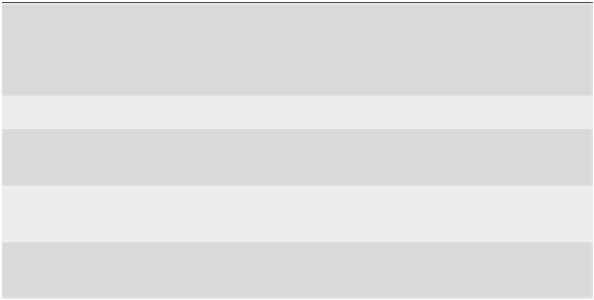Biology Reference
In-Depth Information
Table 1
Impaction parameters in controlled cortical injury (CCI) for rats and mice
Rats
Mice
Mild injury
Severe injury
Mild injury
Severe injury
Velocity
3 m/s
5 m/s
3 m/s
3 m/s
Duration
of impact
90 ms
150 ms
100 ms
100 ms
Depth of
deformation
2.5 mm
3 mm
1 mm
1.5 mm
Impactor tip
(diameter)
8 mm
8 mm
3 mm
3 mm
vital parameters (blood pressure, temperature) are monitored for
2-3 h and then the animal is sacrificed (
41
). In chronic experi-
ments (survival procedure) (
3
), after the TBI the animal is recov-
ered from anesthesia, subjected to behavior studies, imaging studies
and depending on the protocol the animal is sacrificed at a later
time point (1 day, 3 days, 1 week, 2 weeks, 1 month or later).
Similarly, depending on the severity of injury, TBI is classified into
mild TBI or severe TBI which is mainly decided by factors like the
velocity of impact, duration of impact and depth of deformation
(
44-47
) (Table
1
). TBI can also be complicated by secondary
insults such as hypotension or hypoxia, which markedly worsen the
resulting neurological injury. Hypotension following the TBI sim-
ulates the complex situation with the polytrauma patient (
41
).
2
Materials
1. Anesthesia chamber: a fiber glass box (approximately
27 cm × 12 cm × 12 cm) with a lid and an inlet for anesthesia
gases (closer to the floor of box) at one end and outlet (closer
to the roof of box) at another end for scavenging anesthesia
gases.
2. Ventilator: Rats—SAR830P ventilator that is supplied by the
Life Science instruments USA. Mice—Mini-Vent Type 845
(Hugo Sachs Elektronik, March-Hugstetten, Germany)
ventilator.
3. Endotracheal tubes: rats—uncuffed endotracheal tubes are
made using 14/16 G intravenous catheters, No. 2.5 (ID);
mice—endotracheal tubes are made using 22 G intravenous
catheter or PE 60 tubes.
2.1
Anesthesia





















Search WWH ::

Custom Search